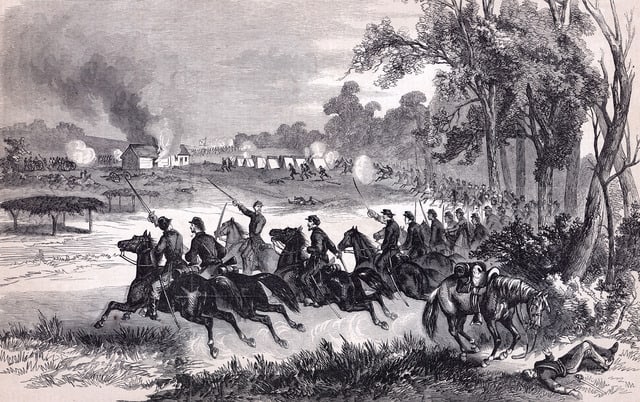July 5, 1863 – July 18, 1863

Union cavalry charge on July 17, 1863 at Honey Springs, Cherokee Nation, in Indian Territory (Oklahoma). Illustration by battlefield reporter James R. O’Neill appeared in Frank Leslie’s Illustrated Weekly, Aug. 29, 1863.
By Phil Kohn
Phil Kohn can be reached at USCW160@yahoo.com
On July 5, 1863, Federal troops attack Warsaw, North Carolina, inland from New Bern and south of Goldsboro, causing damage to the Wilmington and Weldon Railroad. With Vicksburg having capitulated, Maj. Gen. William T. Sherman leads his Union force towards Jackson, Mississippi, where Gen. Joseph Johnston’s Confederates are located.
Skirmishing continues along the route of the Confederate retreat from Pennsylvania on July 6, but the Union army cannot put together an organized, large-scale pursuit.
Still feuding with his subordinate generals, Confederate Gen. Braxton Bragg settles his troops — retreating before Maj. Gen. William Rosecrans’s Union force — in and around Chattanooga, Tennessee, on July 7.
On July 8, Confederate Brig. Gen. John Hunt Morgan and his cavalry raiders cross the Ohio River into Indiana, south of Corydon, where they loot homes and businesses. Panic spreads among the populace as the Confederates continue heading north.
The 6,000 besieged Confederate defenders of Port Hudson, Louisiana, surrender to Union forces on July 9. The losses of Vicksburg and Port Hudson open the Mississippi River to Federal commerce and traffic and split the Confederacy in two.
Having been delayed by high water in the Potomac River, Gen. Lee’s Army of Northern Virginia is finally able to start a three-day crossing back into Virginia on July 10. The same day, U.S. naval and land-based troops begin a series of assaults on Battery Wagner, on Morris Island, off Charleston, South Carolina. The strongly situated Confederates fend off several frontal attacks.
In New York City, on July 11, the first draftees under the auspices of the Enrollment Act of March 3, 1863, are selected. The unpopular law permits the drafting of men between the ages of 20 and 45 into Federal military service for three years. Exemption from the draft is available either by paying $300 to the government or by finding a substitute — someone else who will serve in the army in the draftee’s place.
Fighting occurs on July 12,1863, near Jackson, Mississippi, between Union troops under the command of Maj. Gen. William T. Sherman and Confederates led by Gen. Joseph Johnston.
On July 13, anger and resentment over the drafting of individuals into the U.S. Army boils over and erupts into riots in several Northern cities, including Boston, Massachusetts, Providence, Rhode Island, Buffalo, New York, and Detroit, Michigan. The worst disturbance occurs in New York City, where it takes four days for police, militia and 4,000 Federal troops rushed in from Gettysburg to stem the violence. Many, if not most, of the perpetrators are Irish immigrants (the prevailing sentiment is that they will go to war while emancipated blacks will take their jobs). Accordingly, much of the mayhem is directed toward blacks, who are attacked at random — with at least 11 being lynched. In all, around 120 civilians die (although some sources say at least another 540 deaths were never reported to police) and another 2,000 or so are injured. A quarter of the city’s black residents are left homeless. Many businesses and homes are looted; some 50 buildings, including two churches and an orphanage for black children are burned; and many facilities are damaged, including the offices of Horace Greeley’s New York Tribune newspaper and the home of New York City’s mayor, George Opdyke. Property damages are estimated at around $3.5 million (approximately $84 million in 2023). The same day, John Hunt Morgan and his Confederate raiders enter Ohio, near Cincinnati, heading eastward across the state, skirmishing with Federal troops and militia along the way. In Louisiana, a 6,000-strong Federal force is defeated by Confederates at Cox’s Plantation, near Donaldsonville, south of Baton Rouge.
Reeling from the losses at Gettysburg, Vicksburg and Port Hudson, President Jefferson Davis sends a letter on July 15 to Lt. Gen. Theophilus Holmes, commandant of the Trans-Mississippi Department, stating: “The clouds are truly dark over us.”
Facing nine divisions of Union troops led by Maj. Gen. William T. Sherman, Gen. Joseph Johnston on July 16 orders his Confederate force to retreat from Jackson, Mississippi. Federals occupy the state capital for the second time in two months and again burn the city. The destruction is so complete that Union soldiers call the city “Chimneyville” — brick chimneys, for the most part, being the only structures left standing. Halfway around the world, the U.S. engages in — and wins — its first naval battle with Japan. USS Wyoming, a six-gun screw sloop with Cdr. David McDougal, USN, as captain, is at Yokohama, Japan, while searching for the Confederate raider CSS Alabama. Following much anti-Western agitation (Japan had been opened to the West in 1854), Emperor Kōmei unilaterally abrogated treaties and in March 1863 had declared that all foreigners were to be expelled from the country by June 25. Following the deadline, numerous foreigners still in Japan were assaulted and foreign vessels were attacked by Japanese ships in the crucial, heavily used Shimonoseki Straits. When word reaches Yokohama that the American merchant steamer SS Pembroke has been attacked, Cdr. McDougal, in consultation with the U.S. Minister to Japan, orders Wyoming under way to respond. After a two-day voyage, Wyoming enters the Straits and exchanges fire with shore batteries and engages with three Japanese war vessels. After an hour of fighting, Wyoming withdraws, having sunk one ship and damaging the other two (one of which also sinks), as well as eliminating some of the shore batteries. She then continues hunting for Alabama. (A later military campaign by an alliance of four Western nations forces the emperor to rescind the foreigner-expulsion decree.)
In one of the most heterogeneous battles of the war, 3,000 white, black and Indian Federal troops led by Brig. Gen. James Blunt attack 6,000 Indian and white Confederate soldiers led by Brig. Gen. Douglas Cooper at Elk Creek, near Honey Springs, Cherokee Nation, in Indian Territory, on July 17. It is one of the largest battles on Indian land and the largest of the Civil War in which white soldiers are in the minority. Despite inferior numbers, the Union force is victorious, largely due to superior artillery and the Confederates’ shortage — and in some cases a total lack — of weapons and ammunition. After the battle, the Confederates retreat southward into the Choctaw Nation to the Red River, on the Texas border.
On July 18, the U.S. Army launches its final assault on Battery Wagner, off Charleston, South Carolina. The 6,000 Federal troops, including the 54th Massachusetts Colored Infantry, fail to take the fort and suffer heavy casualties. Multiple failures to take Battery Wagner by frontal assaults force a rethinking of Union strategy, and a siege is established by Federal land troops and naval vessels.







